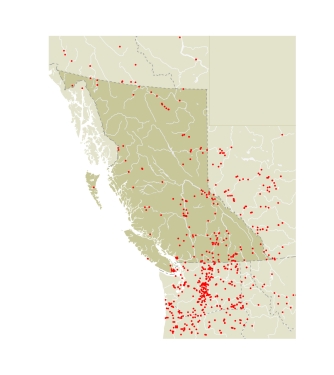Mourning Cloaks are univoltine in BC but are bivoltine in eastern Canada and Colorado (Brown et al. 1957; Layberry et al. 1998). Eggs are laid in cylindrical clusters surrounding a willow twig in the spring. The larvae live in an aggregation until the last instar, when they gradually disperse. There are typically about 100 eggs in a cluster, so the aggregations of larvae cause considerable defoliation of the willow plant on which they are feeding. Mature larvae drop or crawl off their larval foodplant, and wander considerable distances before pupating. They are frequently seen crossing streets and sidewalks at this time. Adults emerge from the pupae a couple of weeks after pupation, in July at low elevations.
At Tofino the first Mourning Cloak was collected hibernating in a woodpile in the mid-1930s; they were unknown before this. A few years later a massive population outbreak occurred in which all the willows on a small island in Tofino Inlet were completely defoliated and thousands of larvae crawled over the island searching for food. The outbreak has not been repeated, and Mourning Cloaks have remained present but uncommon around Tofino (AGG). The population outbreak may have resulted from colonization of the area by the species in response to land clearing, which promoted willow growth in an area originally dominated by conifers. Parasites may initially have been absent or rare, permitting a population outbreak of the butterfly.
Mourning Cloaks feed on poplar tree sap prior to hibernation, and hibernate in various sheltered locations, such as lumber piles and debris piles (CSG; JHS). When they emerge from hibernation on warm days in early spring, they feed on sap from stumps of recently cut trees (Saunders 1869c; CSG). Adults also feed on tree sap or in orchards on fruit juices, and are killed by orchard sprays (Atkinson 1978). Adults sometimes live a full year, with ragged hibernated adults still in flight when their freshly emerged offspring appear in flight (Cockle 1915).
Mourning Cloaks migrate in Europe, where it has long been known that they migrate to Great Britain but are
not permanent residents (Williams 1949a, 1949b). They also migrate south in the fall in eastern North America, using gliding and soaring flight between periods of flapping flight, in a manner similar to that of Monarchs (Gibo 1981). There is no indication that Mourning Cloaks migrate in western North America.
Larval foodplants in BC are willows (Salix scouleriana, S. babylonica, S. alba, and weeping willow), black cottonwood, trembling aspen, and ornamental elm (Harvey 1908; Jones 1942; Sugden, 1970; CSG; FIS). Outside BC other foodplants include Celtis occidentalis, Onobrychis vicifolia, Salix exigua, Salix jeppsoni, and S. bebbiana (Shapiro et al. 1981; Byers and Richards 1986; Scott 1992).
|
